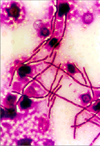Abstract
The first case of haemorrhagic meningitis due to Bacillus anthracis in the European part of Turkey is reported here. B. anthracis, sensitive to penicillin, was isolated from the cerebrospinal fluid and blood cultures. Although appropriate therapy was administered, the patient died two days after hospitalization.
Anthrax incidence is decreasing in Turkey, yet it remains an endemic disease. Half of the cases in Europe are reported from Turkey.1 Anthrax is primarily a disease of herbivores, however it causes cutaneous, respiratory and gastrointestinal infections in humans.2 Meningitis may rarely develop as a result of lymphohaematogenous spread from the primary lesions.3-6 Herein, we present a case of anthrax meningitis due to the cutaneous form of anthrax.
A 36-year old man was admitted with sudden loss of consciousness. His pupils were anisocoric although both pupillary light reflexes were positive. There were no meningeal irritation signs. His body temperature (orally) was 35.5℃, respiration was irregular and pulse rate was 54/min. There were four vesicles (0.5 × 1 cm) surrounded by erythema on his hands and arms. Three lymphadenopathies, with diameters of 6, 4, and 2 cm, were detected in the right and left axillary region.
His white blood cell (WBC) and platelet counts were 25,600/mm3 and 130,000/mm3, respectively. Erythrocyte sedimentation rate was 12 mm/h. The blood biochemical values were normal except for high levels of glucose (143 mg/dl) and AST (73 U/L). C-reactive protein was also elevated (133 mg/dl). Following the discovery of subarachnoid haemorrhage on cerebral computerized tomography (CT) scan, the patient was hospitalized on the advice of the neurosurgeons with the diagnosis of cerebrovascular accident. Although there were no meningeal irritation signs, anthrax meningitis was considered by specialists of infectious diseases because of the presence of skin lesions and subarachnoid haemorrhage. The performance of additional anamnesis detected that the patient had slaughtered a sick sheep a week before admission. In lumbar puncture, the cerebrospinal fluid (CSF) was projectile and haemorrhagic with a WBC count of 1184/mm3, of which 85% was polymorphonuclear leukocytes and plenty of erythrocytes. Large gram-positive bacilli were seen in the CSF smear (Fig. 1). B. anthracis was isolated from cultures of CSF and blood.
Although treatment for anthrax meningitis was started immediately with 24 million U of penicillin G per day, the patient died two days after admission. Autopsy was not performed.
Bacillus anthracis spores enter the human body in three ways. The cutaneous form is acquired through a lesion in the skin; the intestinal form develops on the mucosa of the intestine after the ingestion of B. anthracis spores in the meat of a slaughtered, infected animal, and the pulmonary form by inhalation.1 As in this case, meningitis and sepsis may rarely develop via lymphohaematogenous spread from primary lesion. Cases of anthrax meningitis are very rarely reported in Turkey.3-5 Although cases of anthrax are endemic in the eastern and central parts of Anatolia, it is rarely seen in the European part of Turkey. This is the first reported case in this region. Whereas the cutaneous form is often self-limiting, other forms are usually fatal due to haemorrhagic necrosis in internal organs and lymph nodes.2 Haemorrhagic infiltrations and thrombosis in the vessels surrounding the lesions, and necrosis in the meninges, are seen in the anthrax meningitis.1 As in our case, the characteristic features of anthrax meningitis are gram-positive bacilli in CSF and haemorrhagic CSF; thus CT scan shows subarachnoid haemorrhage.7
Penicillin is used for the treatment of all anthrax forms, although isolates may be rarely penicillin-resistant. 8 B. anthracis, susceptible to penicillin, was isolated from cultures of CSF and blood in the present case. Anthrax meningitis is almost always fatal, with death occurring one to six days after the onset of illness, despite intensive antibiotic therapy.7 In a similar fashion, our case did not respond to the treatment and died within two days.
In conclusion, anthrax meningitis is an extremely rare entity which should always be distinguished from subarachnoid haemorrhage due to cerebrovascular accident and from other forms of haemorrhagic meningitis due to other agents such as herpes viruses or fungi. The clinician should consider anthrax meningitis if there is a history of contact with infected animals or their products. Furthermore, the lumbar puncture and Gram stain should be absolutely applied for differential diagnosis of haemorrhagic meningitis. CT scan alone cannot differentiate anthrax meningitis and may lead to misdiagnosis.
References
1. Doğanay M. Topcu AW, Soyletir G, Doğanay M, editors. Bacillus anthracis and other Bacillus species. Infectious diseases and their microbiology. 2002. Istanbul: Nobel Press;1533–1543.
2. Quinn CP, Turnbull P. Collier LH, Balows A, Sussman M, editors. Anthrax. Topley-Wilson's Microbiology and Microbial Infections, Volume 3, Bacterial Infections. 1998. 9th ed. London: Edward Arnold;799–818.
3. Yorgancıgil B, Demirci M, Ünlü M, Sevik E, Doğanay M. Anthrax meningitis: case report. Int J Infect Dis. 2001. 5:220–221.
4. Taşyaran MA, Deniz O, Ertek M, Çetin K. Anthrax meningitis: case report and review. Scand J Infect Dis. 2002. 34:66–67.
5. Albayrak F, Memikoğlu O, Kurt Ö, Çokça F, Birengel S, Tekeli E. A case of anthrax meningitis. Scand J Infect Dis. 2002. 34:627–628.
6. Garcia AG, Jimenez RR. Bacillus anthracis meningitis. N Engl J Med. 1999. 341:814.
7. Dixon TC, Meselson M, Guillemin J, Hanna PC. Anthrax. N Engl J Med. 1999. 341:815–826.
8. Lalitha MK, Thomas MK. Penicillin resistance in Bacillus anthracis. Lancet. 1997. 349:1522.




 PDF
PDF ePub
ePub Citation
Citation Print
Print



 XML Download
XML Download